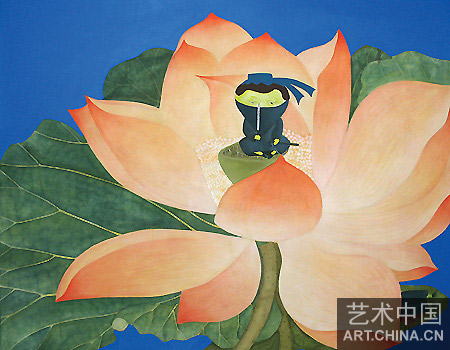
yangtao1
楊濤、于航及其他“古典主義者”對(duì)中國(guó)經(jīng)典的戲仿
龍藝榜畫廊當(dāng)代藝術(shù)聯(lián)展
策展人:世武
2007年8月1日至10月31日
www.LongYiBang.com
+86 010 65307048
反觀歷史,任何人也無法回避其對(duì)現(xiàn)實(shí)的態(tài)度;對(duì)古典題材的創(chuàng)新與顛覆成為藝術(shù)家解脫當(dāng)代精神困局的有效方式。龍藝榜畫廊通過此展覽反映了新銳藝術(shù)家對(duì)古典傳統(tǒng)的現(xiàn)實(shí)思考。他們借用文化傳統(tǒng)的符號(hào)與圖式,無意于焚琴煮鶴,而是采取內(nèi)斂的太極拳式的精神搏擊對(duì)抗現(xiàn)實(shí)問題,作品顯示出毫不妥協(xié)的觀念力量。參展藝術(shù)家包括楊濤、于航、姜川等。
宋代也許是中國(guó)古典輝煌邁向世俗化的轉(zhuǎn)折點(diǎn),令當(dāng)代藝術(shù)家迷戀的花鳥畫與宋江式的草莽英雄、七俠五義泥沙俱下,其社會(huì)精神的變遷與當(dāng)代中國(guó)形成有趣的參照,為我們的精神沖突與救贖提供了一個(gè)支點(diǎn)。有別于洪磊宋代題材作品驚悚的悲劇現(xiàn)場(chǎng),楊濤顛覆宋代經(jīng)典圖式的方式是無厘頭的智慧。他的蒙面劍客跳上汴梁宣德門鴟吻之上,驚飛瑞鶴;占據(jù)蓮臺(tái)、登上宋代花鳥畫的枝頭。楊濤的劍俠不是白玉堂,更不是韋小寶,作為無奈的被日益邊緣化的當(dāng)代文人之一,他的劍俠是禪者,劍指空無,于坐禪中半睜睡眼,在無法逃遁的喧囂中企圖恪守片刻的寧靜,在風(fēng)暴來襲之前抱緊宋代伸過來的一片凋零的樹枝。
于航初期的戲曲題材攝影源于經(jīng)典女性形象如穆桂英、虞姬等,她們堅(jiān)貞而端莊,柔情千尺或傲骨沖天;在其新作中卻讓位于明清話本式小女子低眉淺唱的世俗情懷,從濃墨重彩轉(zhuǎn)向了對(duì)古代市井女伶精神與欲念的窺視,同時(shí)具有含蓄的現(xiàn)實(shí)意義。唐代仕女與明清木版插圖中的女人媚影交疊,或許時(shí)空錯(cuò)亂間我們偶然闖入某個(gè)正在玩Cosplay的女生宿舍;女人們仿佛面對(duì)一面背后有男性窺視的鏡子,顧影自憐,沉浸于市俗情趣的玩味與想象。當(dāng)代人對(duì)時(shí)尚、整容、塑身、美體的熱衷反映著對(duì)身體的物化崇拜,身體作為道具,是謀求社會(huì)認(rèn)同的有效工具。藝術(shù)家關(guān)注對(duì)此文化意義上的追問。縱觀于航一系列以女人身體作為擺設(shè)物的攝影作品,藝術(shù)家也許構(gòu)造著中國(guó)男性關(guān)照女人的精神圖譜,探詢先天的文化烙印如何主宰著我們對(duì)女性身體的幻想與趣味,如美國(guó)女詩人普拉斯所說的:“而在深潭之底,眾多的星星,支配著你的一生。”
參展作品同時(shí)顯示了唯美的回歸,對(duì)純粹的中國(guó)古典美圖式的昄依。媒介包括油彩、丙稀、影像和版畫等。
Girls Dormitory in the New City of BianLiang,
Chinese Classical at Play.
Contemporary Art Exhibition
August 1st-Ocober 31st, 2007
Curator: Shi Wu
Amelie Gallery, Beijing
www.LongYiBang.com
+86 010 65307048
Subversive disruption of classical Chinese motives is an effective tactics for contemporary avant-gardes addressing their social concerns. Amelie Gallery’s new exhibition features works by artists who borrow classical Chinese culture icons. With sharp playfulness, they practice sensitive and subtle Tai Ji Quan (slow-motion Chinese boxing) to challenge reality, demonstrating an uncompromised conceptual edge. Participating artists include Yang Tao, Yu Hang, Jiang Chuan etc..
The Song Dynasty is perhaps a historical milestone before the magnificence of Chinese classical spirit faded into secularism. Its dramatic social and mental transformation provides an intriguing frame of reference for contemporary Chinese artists. Different from well-known conceptual photography artist Hong Lei’s intensely tragic scenes are Yang Tao’s Song Dynasty classical paintings which intrude in a frolicsome way with black humor. Inspired by Song Dynasty emperor/artist Zhao Ji’s famous painting (which depicts cranes soaring above the splendid palace in BianLiang, then the capital city), Yang’s swordsmen jump onto the palace roof, flushing cranes out of the sky. In other pieces, Yang rests in the heart of a lotus holding a blood-splattered sword, or plants himself on a branch; with half-opened eyes, he can hardly fall asleep. Yang Tao’s swordsman is a pursuer of Zen and at the heart of inescapable hurricanes, he tries to hold a piece of foliage from Song Dynasty.
Female artist Yu Hang concentrates on photography featuring the female body in traditional settings. Her earlier works Beauty with Sword took inspiration from Chinese heroines Mu GuiYing and Yu Ji etc. In the new works, these solemn and dignified figures give way to mundane girls in Ming and Qing Dynasties’ fiction; classicism is replaced by secularity. Whild indulging themselves naked in a private, liberating moment in front of mirror, the girls also willingly present themselves to a male’s gaze from behind the mirror.
Today’s fashion and cosmetology indicate a mentality of treating body as an object, as an effective tool pursuing social status. Yu Hang’s message is very much relevant today, her works not only captures fantasized imagination from traditional literature, but also illusions of cosplay game in a modern girls’ dormitory. By these works, artist Yu Hang explores how female perceive their bodies in a male-dominated social mentality. She also tries to construct a cultural and mental map, examining the fact that our traditionary culture imprints our obsession and fantasy on the female body.
The works visually comply with classical Chinese aesthetics, allowing the conceptual subtlety beneath unleashes itself. Media include acrylic, photography and silkscreen prints.
龍藝榜畫廊 中國(guó)北京
11:00-19:00, 周二至周日
中國(guó)北京朝陽區(qū)建國(guó)路89號(hào)
華貿(mào)中心5號(hào)樓H座505
乘車路線:地鐵大望路東北角
Amelie Gallery, Beijing
11am-19pm, Tuesday-Sunday
505, No. 5 Building, China Central Place(HuaMao),
No. 89, Jian Guo Rd., Chao Yang Dist., Beijing
How to get there: Subway DaWangLu station.

yangtao2
|

